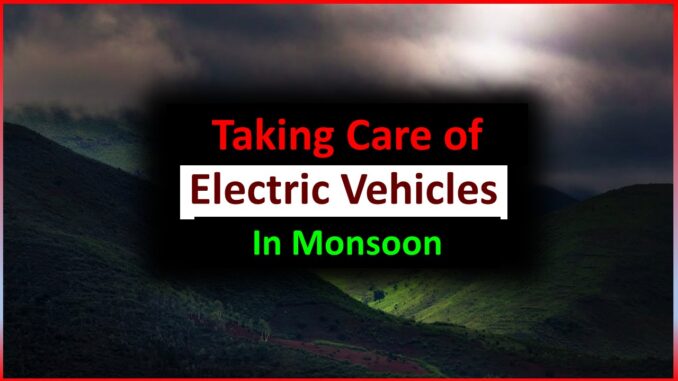
As the monsoon season arrives, it’s essential to pay special attention to the maintenance of your electric vehicle. How to take care of EVs during monsoon season?
Although modern EVs are rugged and well-built like any vehicle of their class, Monsoon conditions may pose unique challenges for EVs and may affect their performance and longevity if not taken care of. We can always rely on some simple yet effective tips, to ensure that your electric vehicle stays in top-notch condition throughout the rainy season.
Taking Care of EVs During Monsoon
Let’s explore the best practices for taking care of your EV during the monsoon.
#1. Regularly Inspect and Clean the Exterior
During the monsoon, the exterior of your electric vehicle is exposed to mud, dirt, and water, which can accumulate on the surface and obscure visibility. Regularly inspect your EV’s body for any signs of damage, scratches, or dents that may need attention.
Additionally, keep your EV clean by washing it regularly. This helps prevent corrosion caused by contaminants that may get trapped in hard-to-reach areas.
Here are some tips to take care of Your EV exterior nice and clean
- Choose a water and mild soap solution instead of harsh chemical-based cleaning solutions.
- Harsh chemicals may decrease the glossy finish of your EV.
- Once the washing is done, be sure to fully rinse your EV.
- Any soap residue that is still on the surface will draw filth and debris, which can cause corrosion.
- It is equally important to immediately dry your EV after washing. This will reduce the risk of water leaking into any of the electrical parts.
- Get a nice polish for your EV.It will help your EV glossy finish to last longer
#2. Check and Maintain the Battery
The battery is the heart of an electric vehicle and also the most expensive part as well. For these reasons, EV batteries require special attention during the monsoon. Before the rainy season begins, inspect the battery for any signs of leakage or damage.
If you notice any issues, have it serviced or replaced promptly.
To protect the battery during the monsoon, avoid driving through deep water or flooded areas. If you accidentally encounter such conditions, stop the vehicle immediately and choose a different route.
Water intrusion can damage the battery and other electrical components, leading to expensive repairs.
Protecting your EV’s charging port from water damage is crucial because it is a delicate instrument. To keep the port dry, install a weatherproof cover or flap.
If you don’t have a cover or flap, you might try covering the port while not in use with a water-resistant material.
#3. Inspect Tires and Brakes
As with any automobile, proper tire maintenance is crucial for the safety and performance of your EV, especially during the monsoon. Check the tire tread depth regularly and ensure they are inflated to the manufacturer’s recommended levels.
Adequate tire tread will provide better grip on wet roads and reduce the risk of skidding.
Likewise, inspect the brake system for wear and tear. Spongy brakes or unusual noises may indicate a problem that requires immediate attention. Efficient brakes are essential for safe driving on slippery surfaces.
#4. Maintain the Interior
Monsoon rains can bring in a significant amount of mud and water into the car’s interior. Keep the floor mats clean and dry to prevent the growth of mildew. Using rubber mats instead of fabric ones can make cleaning easier.
Moreover, check the condition of the seals around doors and windows. Damaged seals can lead to water seepage inside the car, causing electrical malfunctions and discomfort.
Additionally, be aware of your battery pack’s IP rating. The critical parts of most current EVs are tightly sealed and have strong IP ratings, however, there are regrettable occasions where a faulty connector or extended exposure to water can lead to damage.
#5. Drive Cautiously
During heavy rains, exercise extra caution while driving your EV. Reduced visibility and slippery roads can lead to accidents. Drive at moderate speeds, maintain a safe distance from other vehicles, and avoid sudden braking or acceleration.
Utilize the regenerative braking feature to improve control and conserve energy.
#6. Avoid Driving Over Puddles
Drive cautiously and gently through any puddles you must. Avoid driving through deep puddles since this might harm the undercarriage of your electric vehicle. Be cautious to inspect your EV for indications of damage if you do drive through a puddle.
Conclusion
Yes, EVs require some special treatment during the monsoon. Taking care of your electric vehicle during the monsoon is essential to ensure its optimal performance and longevity.
Regularly inspecting and cleaning the exterior, checking and maintaining the battery, inspecting tires and brakes, protecting the charging system, and maintaining the interior are vital steps in safeguarding your EV during the rainy season.
By following these simple yet effective tips, you can enjoy a safe and hassle-free driving experience even when the monsoon is at its peak.